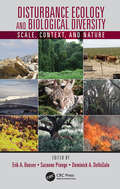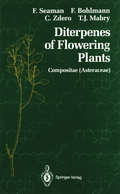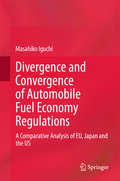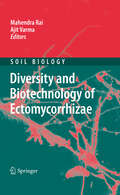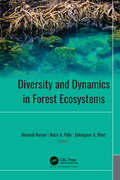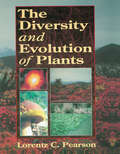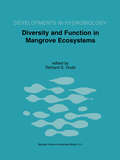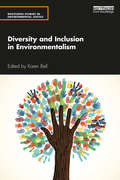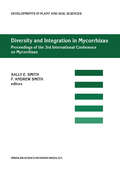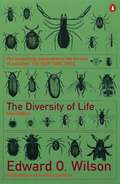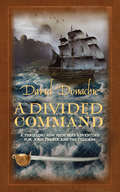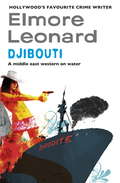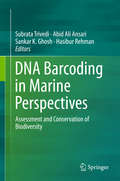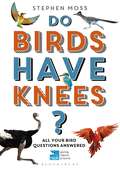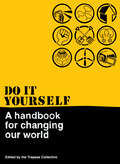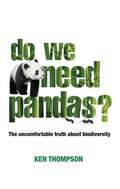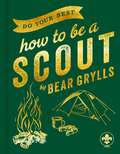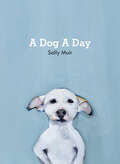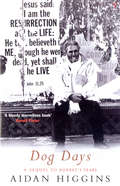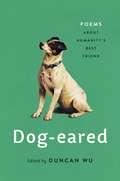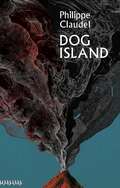- Table View
- List View
Disturbance Ecology and Biological Diversity: Context, Nature, and Scale
by Erik A. Beever Inger Suzanne Prange Dominick A. DellaSalaThis book presents cascading effects of ecological disturbances on a multitude of ecosystem components. It includes agricultural development, large infrequent disturbances, forest harvesting, non-native grazing in deserts, ground transportation, powerline corridors, fires, urban ecology, disturbance in aquatic ecosystems, land-use dynamics on diversity, habitat fragmentation, sedimentation of wetlands, and contemporary climate change. The book facilitates users in understanding why disturbances are occurring while recommending mitigation and remediation strategies.
Diterpenes of Flowering Plants: Compositae (Asteraceae)
by Fred Seaman Ferdinand Bohlmann Christa Zdero Tom J. MabryMore than 1200 diterpenes have been identified from approximately 550 Compo sitae taxa (Figure 1 [pp. 219-384], Tables 1-3 [pp. 7-218]). The annual output of such reports rose sharply during the past several years, a trend that was also reflected by other major lipophilic constituents of the Compositae: acetylenes (63, 465), sesquiterpene lactones (266, 458), and benzofurans and chromenes (429). Unlike these other natural products, no review of the diterpene chemistry of the Compositae has been published. Given the bulk of data currently on hand, a review of this topic is clearly overdue. Several major goals influenced the preparation of this review. The first was to provide a useful reference to guide terpenoid chemists to the literature of known compounds. The published reports for 1200 structures provide a sizable body of spectroscopic data applicable to the investigation of new compounds. The study of diterpenes has been hampered by the absence of an all-inclusive nomenclature and classification system for the various skeletal types. Conse quently, a second goal was to organize structural data into a classification scheme designed to group compounds by biogenetic homology, and to standardize such features as diterpene nomenclature and numbering. Pursuant to this goal, the published names (Table 1) and numbering systems (Table 2) for all compounds are included.
Divergence and Convergence of Automobile Fuel Economy Regulations: A Comparative Analysis of EU, Japan and the US
by Masahiko IguchiThis book reveals the mechanisms underlying the convergence of car fuel economy regulations in Europe, Japan and the US by drawing upon a constructivist theory of International Relations and law that focuses on business competition and environmental regulations. It offers new understanding of the topic of cars and an issue of climate change, discussing the emerging phenomenon of convergence of fuel economy regulations; addressing the role of business actors in pushing for climate change action; proposing the new model of agency with and beyond states; and providing insightful case studies from Europe, Japan and the US.The opening chapter reviews the automobile industry and global climate change, providing a background for the discussion to follow. Chapter 2, Business Actors and Global Environmental Governance, grounds the discussion in the field of environmental governance. The third chapter is a case study examining the construction and timing of the European Union's climate policies for automobile CO2 emissions, discussing the underlying factors and the actors influencing the policies. The following chapter argues that Japan adopted its stringent fuel economy regulations primarily because of industry competitiveness, motivated by stringent environmental regulations in export markets and encouraged by a tradition of ‘co-regulation’ and ‘corporatism’ to enhance the regulations. Chapter 5 asks why the US, the first country to introduce fuel economy regulations, spent two decades in regulatory stagnation, and discusses how recent US fuel economy regulations came to converge with Japanese and European standards.Chapter 6 compares, contrasts and analyzes fuel economy regulations among the three case studies and identifies policy implications for the future climate governance for 2015 and beyond. The final chapter explores applicability of the ‘agency with and beyond the state’ model to other sectors and to climate governance as a whole.
Diversity and Biotechnology of Ectomycorrhizae (Soil Biology #25)
by Mahendra Rai and Ajit VarmaEctomycorrhizal fungi play multifunctional roles during symbioses with higher plants. They can serve as bioprotectors, biofertilizers, bioremediators and stress indicators. Further, they are the true “mycoindicators” of forest ecosystems, where an enormous diversity of ectomycorrhizal fungi can be found. Some ectomycorrhizal fungi also produce edible sporocarps, i.e., fruiting bodies, which are important for the food industry. Ectomycorrhizal fungi also produce various metal chelating molecules, which are of remarkable biotechnological significance and which also secrete useful secondary metabolites. Molecular approaches are required for the identification and differentiation of fungi forming symbioses with higher plants, while molecular tools are important to understand how genes are expressed during symbiosis with higher plants. Students, researchers and teachers of botany, mycology, microbiology, forestry, and biotechnology will find a valuable source of information in this Soil Biology volume.
Diversity and Dynamics in Forest Ecosystems
by Munesh KumarProviding a wealth of in-depth knowledge of forest ecosystems, this new volume explores a collection of important topics on forest community dynamics. It looks at the diversity of forest ecosystems and explores such aspects as forest products in enhancing local livelihoods and community participation, forage production, forest conservation and sustainable management, regeneration patterns, seed handling, and more. Chapters in Diversity and Dynamics in Forest Ecosystems present new research on forest products, livelihood generation mechanisms of forest-dependent communities, utilization patterns of untapped resources from forests, and the structure of different ecosystems from the tropical to the temperate landscape. This book also features different drivers of community dynamics, such as the role of seed handling in forests, the influence of altitudinal variations, and protected and community-conserved forests on the forest diversity. Chapters also consider the role of non-timber forest products and their significance in livelihood diversification for tribal communities and forage crop genetic resources, and forest resource extraction by forest fringe dwellers. Also explored are aspects of soil organic carbon in agroforestry systems and integrated approaches of sustainable agroforestry development in diverse forest ecosystems. This edition also examines the vegetation structure and regeneration aspects of timberline zone, including diversity of herbaceous flora along the altitudinal gradient. The abundance of in-depth knowledge of the diversity and dynamics of forest ecosystems in this volume will be valuable in conservation and management of forests, which play an important role in the world environment. Forests are presently facing multiple disturbances, and this volume will help forestry professionals and others formulate further strategies to mitigate global climate change and other challenges.
Diversity and Dynamics in Forest Ecosystems
by Munesh Kumar Nazir A. Pala Jahangeer A. BhatProviding a wealth of in-depth knowledge of forest ecosystems, this new volume explores a collection of important topics on forest community dynamics. It looks at the diversity of forest ecosystems and explores such aspects as forest products in enhancing local livelihoods and community participation, forage production, forest conservation and sustainable management, regeneration patterns, seed handling, and more. Chapters in Diversity and Dynamics in Forest Ecosystems present new research on forest products, livelihood generation mechanisms of forest-dependent communities, utilization patterns of untapped resources from forests, and the structure of different ecosystems from the tropical to the temperate landscape. This book also features different drivers of community dynamics, such as the role of seed handling in forests, the influence of altitudinal variations, and protected and community-conserved forests on the forest diversity. Chapters also consider the role of non-timber forest products and their significance in livelihood diversification for tribal communities and forage crop genetic resources, and forest resource extraction by forest fringe dwellers. Also explored are aspects of soil organic carbon in agroforestry systems and integrated approaches of sustainable agroforestry development in diverse forest ecosystems. This edition also examines the vegetation structure and regeneration aspects of timberline zone, including diversity of herbaceous flora along the altitudinal gradient. The abundance of in-depth knowledge of the diversity and dynamics of forest ecosystems in this volume will be valuable in conservation and management of forests, which play an important role in the world environment. Forests are presently facing multiple disturbances, and this volume will help forestry professionals and others formulate further strategies to mitigate global climate change and other challenges.
The Diversity and Evolution of Plants
by Lorentz C. PearsonThis exciting new textbook examines the concepts of evolution as the underlying cause of the rich diversity of life on earth-and our danger of losing that rich diversity. Written as a college textbook, The Diversity and Evolution of Plants introduces the great variety of life during past ages, manifested by the fossil record, using a new natural classification system. It begins in the Proterozoic Era, when bacteria and bluegreen algae first appeared, and continues through the explosions of new marine forms in the Helikian and Hadrynian Periods, land plants in the Devonian, and flowering plants in the Cretaceous. Following an introduction, the three subkingdoms of plants are discussed. Each chapter covers one of the eleven divisions of plants and begins with an interesting vignette of a plant typical of that division. A section on each of the classes within the division follows. Each section describes where the groups of plants are found and their distinguishing features. Discussions in each section include phylogeny and classification, general morphology, and physiology, ecological significance, economic uses, and potential for research. Suggested readings and student exercises are found at the end of each chapter.
The Diversity and Evolution of Plants
by Lorentz C. PearsonThis exciting new textbook examines the concepts of evolution as the underlying cause of the rich diversity of life on earth-and our danger of losing that rich diversity. Written as a college textbook, The Diversity and Evolution of Plants introduces the great variety of life during past ages, manifested by the fossil record, using a new natural classification system. It begins in the Proterozoic Era, when bacteria and bluegreen algae first appeared, and continues through the explosions of new marine forms in the Helikian and Hadrynian Periods, land plants in the Devonian, and flowering plants in the Cretaceous. Following an introduction, the three subkingdoms of plants are discussed. Each chapter covers one of the eleven divisions of plants and begins with an interesting vignette of a plant typical of that division. A section on each of the classes within the division follows. Each section describes where the groups of plants are found and their distinguishing features. Discussions in each section include phylogeny and classification, general morphology, and physiology, ecological significance, economic uses, and potential for research. Suggested readings and student exercises are found at the end of each chapter.
Diversity and Function in Mangrove Ecosystems: Proceedings of Mangrove Symposia held in Toulouse, France, 9–10 July 1997 and 8–10 July 1998 (Developments in Hydrobiology #145)
by Richard StandifordMangroves are salt-adapted plants that are found along many of the world's tropical and sub-tropical coastlines. Regrettably, these plants are being lost due to over-exploitation, pollution, conversion to agriculture and aquaculture and other causes. This is having important consequences for local human populations that traditionally rely on this resource, and is upsetting the fine balance needed to maintain this highly productive ecosystem. This text brings together some papers from two recent international symposia on the mangrove ecosystem. It provides an outline of future directions in mangrove research considered to be urgent by prominent mangrove scientists. Contributions include aspects of population differentiation in mangrove species that have been very little studied so far, ecological function, and restoration and management of the mangrove ecosystem. This book is intended for scientists actively working in the areas of mangrove ecology and management.
Diversity and Inclusion in Environmentalism (Routledge Studies in Environmental Justice)
by Karen BellThis book discusses how to develop green transitions which benefit, include and respect marginalised social groups. Diversity and Inclusion in Environmentalism explores the challenge of taking into account issues of equity and justice in the green transformation and shows that ignoring these issues risks exacerbating the gap between the rich and the poor, the marginalised and included, and undermining widespread support for climate change mitigation. Expert contributors provide evidence and analysis in relation to the thinking and practice that has prevented us from building a broad base of people who are willing and able to take the action necessary to successfully overcome the current ecological crises. Providing examples from a wide range of marginalised and/or oppressed groups including women, disabled people, Black, Asian and Minority Ethnic (BAME) people and the lesbian, gay, bisexual, transgender, queer/questioning and others (LGBTQ+) community, the authors demonstrate how the issues and concerns of these groups are often undervalued in environmental policy-making and environmental social movements. Overall, this book supports environmental academics and practitioners to choose and campaign for effective, equitable and widely supported environmental policy, thereby enabling a smoother transition to sustainability. This volume will be of great interest to students, scholars and practitioners of environmental justice, social and environmental policy, planning and environmental sociology.
Diversity and Inclusion in Environmentalism (Routledge Studies in Environmental Justice)
by Karen BellThis book discusses how to develop green transitions which benefit, include and respect marginalised social groups. Diversity and Inclusion in Environmentalism explores the challenge of taking into account issues of equity and justice in the green transformation and shows that ignoring these issues risks exacerbating the gap between the rich and the poor, the marginalised and included, and undermining widespread support for climate change mitigation. Expert contributors provide evidence and analysis in relation to the thinking and practice that has prevented us from building a broad base of people who are willing and able to take the action necessary to successfully overcome the current ecological crises. Providing examples from a wide range of marginalised and/or oppressed groups including women, disabled people, Black, Asian and Minority Ethnic (BAME) people and the lesbian, gay, bisexual, transgender, queer/questioning and others (LGBTQ+) community, the authors demonstrate how the issues and concerns of these groups are often undervalued in environmental policy-making and environmental social movements. Overall, this book supports environmental academics and practitioners to choose and campaign for effective, equitable and widely supported environmental policy, thereby enabling a smoother transition to sustainability. This volume will be of great interest to students, scholars and practitioners of environmental justice, social and environmental policy, planning and environmental sociology.
Diversity and Integration in Mycorrhizas: Proceedings of the 3rd International Conference on Mycorrhizas (ICOM3) Adelaide, Australia, 8–13 July 2001 (Developments in Plant and Soil Sciences #94)
by Sally E. Smith F. Andrew SmithThis book is highly recommended on the basis of the following points: - The editors are highly regarded in the field of mycorrhizal biology and one is co-author of the most comprehensive textbook on mycorrhizas; - Chapters by international experts based on invited presentations at the 3rd International Conference on Mycorrhizas, supplemented by invited chapters on special topics; - Mycorrhizas are being increasingly recognised as ubiquitous plant/fungal symbioses, with the potential to influence the function and ecology of around 90% of all land plants; perhaps the most common and also ancient terrestrial symbioses in existence; - This book has a broad coverage of biology of symbioses between mycorrhizal fungi and plants, especially ecto- and arbuscular mycorrhizas (other recent texts have focused mainly on arbuscular mycorrhizal symbioses); - Forward-looking review chapters by keynote speakers including an overview of research challenges for the future; - Up-to-date research focus; - Coverage includes: molecular diversity and detection of mycorrhizal fungi; cellular and molecular interactions between the symbionts; physiology of the interactions; implications of the symbioses for ecosystem processes, including agriculture; - Several complementary chapters on some topics, ensuring that different perspectives are presented (recent edited volumes have had a smaller group of authors and hence narrower focus); - Readership from advanced undergraduate students in biology (particularly plant science), postgraduate students and researchers in universities and government agencies.
The Diversity of Life: The Diversity Of Life (Questions Of Science Ser. #1)
by Edward O. Wilson"Not since Darwin has an author so lifted the science of ecology with insight and delightful imagery" - Richard Dawkins In this book a master scientist tells the great story of how life on earth evolved. E.O. Wilson eloquently describes how the species of the world became diverse, and why the threat to this diversity today is beyond the scope of anything we have known before. In an extensive new foreword for this edition, Professor Wilson addresses the explosion of the field of conservation biology and takes a clear-eyed look at the work still to be done.
A Divided Command (John Pearce #10)
by David Donachie1794. The Mediterranean is proving dangerous waters for John Pearce and his Pelicans. Having left his lover Emily, who is also the wife of his mortal enemy Ralph Barclay, in the Tuscan port of Leghorn, Pearce is detained in Naples. When he unknowingly delivers a letter promoting the shady and incompetent Admiral Hotham, Pearce finds himself entangled in a political plot that soon puts those closest to him at peril. When reunited with Emily, John Pearce faces a losing battle to keep her reputation intact. Although his Pelicans aid in the endeavour, Emily sees no future for her with Pearce and leaves while he is conveying private letters for Horatio Nelson to the British Ambassador, Sir William Hamilton. Learning of Emily's departure, Pearce sets off in pursuit and has to take on the superior force of Barbary Corsairs who have targeted the merchant ship Emily is travelling on, the Sandown Castle. Outgunned by a barbaric opponent, John Pearce's chances of survival - as well as those of Emily and Pearce's crew - are dubious. And even if they can win this fierce battle, another threat looms on the horizon as Pearce is not the only one chasing Emily; Ralph Barclay has learned of his wife's desertion and is on his way to recapture her.
Djibouti: A Novel
by Elmore LeonardA western on water from the grand master of American crime. Dara Barr, documentary filmmaker, is at the top of her game. She’s covered Bosnian women, Neo-Nazis and post-Katrina New Orleans (for which she won an Oscar), but now she’s looking for an even bigger challenge. So she and her right-hand-man - a 6-foot-six, 72-year-old, African-American name Xavier - head to Djibouti on the Horn of Africa to tackle modern-day pirates. Once they start filming though, they find a whole lot more than they bargained for. They quickly learn that almost nobody in Djibouti is what he seems. A whole mob of colourful characters patrols the surrounding seas, including a pirate chief who keeps a BMW in Djibouti and a cultured Saudi diplomat with dubious connections. There’s a billionaire American who plays different roles as the moods strike him. He loves champagne and firing his 600-calibre elephant gun. If his girlfriend Helene gets seasick or bored, he won’t marry her. And there’s an Al Qaeda terrorist from Miami with very lofty ambitions, who wants to blow up something big. What Dara and Xavier don’t know is which guy is going to get the prize - and what they’ll have to do if they want it.
DNA Barcoding in Marine Perspectives: Assessment and Conservation of Biodiversity
by Subrata Trivedi Abid Ali Ansari Sankar K. Ghosh Hasibur RehmanMore than two third of the surface area of our planet is covered by oceans and assessment of the marine biodiversity is a challenging task. With the increasing global population, there is a tendency to exploit marine recourses for food, energy and other requirements. This puts pressure on the fragile marine environment and needs sustainable conservation efforts. Marine species identification using traditional taxonomical methods are often burdened with taxonomic controversies. Here in this book we will discuss the comparatively new concept of DNA barcoding and its significance in marine perspective. This molecular technique can be helpful in the assessment of cryptic species which are widespread in marine environment, and can also be used to link the different life cycle stages to the adult which is difficult to accomplish in marine ecosystems. Other advantages of DNA barcoding include authentication and safety assessment of seafood, wildlife forensics, conservation genetics and detection of invasive alien species (IAS). Global DNA barcoding efforts in the marine habitat include MarBOL, CeDAMar, CMarZ, SHARK-BOL, etc. DNA barcoding of different marine groups ranging from the microbes to mammals is to be revealed. In conjugation with newer and faster techniques like high throughput sequencing, DNA barcoding is serving as an effective modern tool in marine biodiversity assessment and conservation.
Do Birds Have Knees?: All Your Bird Questions Answered (RSPB)
by Stephen MossThis RSPB-endorsed book answers all those burning questions about birds that beginners and experts alike may ask themselves as they go about their birding. How do ducks keep their feet from freezing in winter? Why don't swallows stay in Africa? Are birds really dinosaurs, or were dinosaurs really birds? And do birds have knees?Taking a 'questions and answers' approach, each specific question leads to an answer which expands the theme under discussion, so that all aspects of bird life and the hobby of birding are covered. The scientifically rigorous answers together form an impressive and fascinating body of bird-related information. This highly readable book will intrigue anyone with an interest in birds.
Do Birds Have Knees?: All Your Bird Questions Answered (RSPB)
by Stephen MossThis RSPB-endorsed book answers all those burning questions about birds that beginners and experts alike may ask themselves as they go about their birding. How do ducks keep their feet from freezing in winter? Why don't swallows stay in Africa? Are birds really dinosaurs, or were dinosaurs really birds? And do birds have knees?Taking a 'questions and answers' approach, each specific question leads to an answer which expands the theme under discussion, so that all aspects of bird life and the hobby of birding are covered. The scientifically rigorous answers together form an impressive and fascinating body of bird-related information. This highly readable book will intrigue anyone with an interest in birds.
Do It Yourself: A Handbook For Changing Our World
by Trapese CollectiveDo you really want to change the world? If the answer is YES, then this book shows you how. Ethical consumerism is now big business. But leading a sustainable and truly radical life encompasses a whole variety of things that challenge the mainstream. This book shows how we can make real changes to the way we live. In simple steps, it describes how you can create sustainable and equitable ways of living that can help transform not just your own life, but the culture around you. The book weaves together analysis, stories and experiences. It combines in-depth analytical chapters followed by easy to follow 'How to Guides' with practical ideas for change. Taken together, these small steps can move us towards taking back control of our lives from governments and corporations.
Do We Need Pandas?: The Uncomfortable Truth About Biodiversity
by Ken ThompsonHow much do we really know about the species that make up the natural world? All over the world, biodiversity is gravely threatened – by overfishing, habitat destruction, pollution and climate change. Yet life on Earth has previously experienced five episodes of mass extinction, and nature has repeatedly proved itself to be a resilient, regenerative force. In this fascinating book, ecologist Dr. Ken Thompson surveys the Earth's biodiversity, its origins and some of the threats it currently faces. Thought-provoking and deeply engaging, Do We Need Pandas? offers a non-technical overview of our ecosystems and expands on the causes and consequences of biodiversity loss. Importantly, it also examines what we should be doing to secure the survival not only of the species with which we share the planet, but of ourselves – and whether we need to be more concerned about ecosystems as a whole than about iconic species such as the orangutan and giant Panda.
Do Your Best: How to be a Scout
by Bear GryllsWhat more could you ask for, than a book stuffed like an overfilled rucksack with tips and tricks from one of the world's most celebrated adventurers from pitching a tent, leading a team, how to keep fit, tie knots, memorise facts, identify trees, stars and birds, as well as learning real survival skills like putting up a tent in the wild and stashing your breakfast in ground to keep it hot for the next morning?This is the book for anyone who is a Scout, was a Scout, or wants to be a Scout.Do Your Best is the handbook for every Scout, young and old. It's a warm-hearted book in which you'll learn all the skills the scouts use to do their best in everything they do and set themselves up to face life head-on and make a real difference in the world.Not since Scouting for Boys, the seminal 1908 book by Robert Baden-Powell that sparked the global movement, has there been a single handbook for every Scout. Whoever you are it will help you step up, speak up, skill up and dream big.Grab life with both hands, never give up and give life you your best shot with Do Your Best: How To Be a Scout. Stunningly typograhically designed and richly illustrated, this will be the perfect Christmas gift for the adventurer in your life -- young or old.Chapters include: 'How to Survive'; 'How to give first aid'; 'How to protect our planet'; 'How to be organised'; 'How to be an adventurer'; 'How to be a camp cook'; 'How to live freely'; 'How to predict the weather'; 'How to be a team player'. And that's just for starters!
A Dog A Day
by Sally MuirA Dog A Day began life with a Facebook post in 2013: 'My name is Sally Muir and this is a new gallery where I will add a dog drawing/painting every day, adding up to a massive 365 day dogfest.'
Dog Days
by Aidan Higgins'Tired of walking in the dream I have returned to the country where I was born half a century ago' - The Higgins family is now dispersed; the third son of four brothers is himself the father of three sons in a family also dispersed, and our author 'looking for the quietness that Julian Sorel found in prison. ' he finds this problematical peace, sharing a bungalow near Brittas in Co Wicklow in an awkward two year tenancy with a school mistress with back back trouble. DOG DAYS is an account of those two years, with flashbacks to previous diaries that reveal a murky Dublin of whores and Provo killing, a raindrenched Connemara.
Dog-eared: Poems About Humanity's Best Friend
by Duncan WuFrom Homer to Wordsworth to Gwendolyn Brooks, learn about history's greatest writers and the furry best friends that inspired them.Dogs are at once among the most ordinary of animals and the most beloved by mankind. But what we may not realize is that for as long as we have loved dogs, our poets have been seriously engaged with them as well.In this collection, English professor Duncan Wu digs into the wealth of poetry about our furry friends to show how varied and intimate our relationships with them have been over the centuries. Homer recounts how Odysseus's loyal dog recognizes his master even after his long absence. Thomas Hardy wrote poems from a pooch's perspective, conveying a powerful sense of dogs' innocent and trusting nature. And a multitude of writers, from Lord Byron to Emily Dickinson, have turned to poetry to mourn the loss of beloved dogs. Rich and inviting, Dog-eared is a spellbinding collection of poetic musings about humans and dogs and what they mean to each other.
Dog Island
by Philippe ClaudelThe Dog Islands are a small, isolated cluster of islands in the Mediterranean - so called because together, when viewed from above, they form the shape of a dog, twisting and baring its teeth against a brilliant blue sea. One of the only inhabited islands (the one that takes the place of one of the dog's teeth) is dominated by a gently smoking volcano, fringed by black volcanic beaches and under the iron rule of the heads of community who are loath to let any outside influence disrupt the quiet way of life on the island.Then one morning, an old woman comes across three bodies that have washed up with the tide: three young black men, who have apparently drowned in their attempt to cross the sea. The initial reaction of the island community is that this tragedy must be covered up, lest any association with the drownings damages the island's tourism industry . . .But the island's deliberate isolation from the realities of the world cannot last for long, and when a visiting detective arrives on the island and starts asking awkward questions, it becomes clear that the deaths of these three men indicate something far more sinister and deeply rotten lying at the heart of this godforsaken fragment of sea-bound land.
